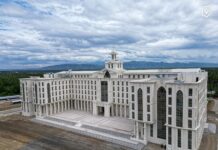ISSUES of moral deterioration, rapid globalization, and materialism have tested the spirituality of the Catholic laity over the years. Now, adding to the list are the unresolved controversies in the priesthood, which could topple their waning faith.
This year’s UST Theology Week with the theme “The Catholic Priesthood: Then and Now,” primarily focused on the loss of the priesthood’s “natural esteem” and “ecclesial conscience” brought about by the different controversies that haunt it, as well as the great influence of contemporary philosophies of new age religion. The week-long celebration ran from April 12 to 16 at the UST Martyr’s Hall.
“Two different conceptions of the priesthood are frequently compared and at times set against each other, in theological milieu as well as in actual pastoral practice and the formation of the clergy,” said Fr. Rodel Aligan, O.P., dean of the Faculty of Sacred Theology.
“There is, on one hand, a social and functional concept that defines the essence of priesthood with the concept of ‘service’— service to the community in the fulfillment of a function,” he said.
“On the other hand, there is the sacramental-ontological concept, which of course does not deny the priesthood’s character of service, but sees it anchored to the minister’s existence and claims that this existence is determined by sacraments.”
Sponsored by the Faculty of Sacred Theology in cooperation with the Institute of Religion, the event served as the University’s contribution to the celebration of the Year of the Priests proclaimed by Pope Benedict XVI.
Priesthood then and now
The Old Testament presents priests as the mediator of the covenant between God and man. In the book of Hebrews, Christ is presented as the eternal high priest —the one who overpowered temptation and offered his own body for the salvation of mankind.
“They (priests) celebrate the sacrament and represent Christ by being true to their identity,“ Aligan said. “When you are true to your identity, you can act as you are.”
Fr. Winston Cabading, O.P., said that during the time of the church fathers, society had an idealist perspective toward priesthood. He mentioned that from a persecuted religion during the reign of Nero, Christianity made its way to be recognized as an imperial church years after under Theodosius I.
According to St. Gregory of Nazianzen, priesthood is considered as an art. “It provides the soul with wings. It rescues it from the world and gives it to God, and watches over it which is in His image,” he said.
Cabading also enumerated virtues of worth and unworthy ministers, citing that those who are quarrelsome, cluttered by power, lived sumptuous, ambiguous with their faith, and want to make their neighbor evil like themselves are poor defenders of faith.
“To undertake the training of others before being sufficiently trained, is to [play] with religion at the expense of the other soul,” he said, reiterating the perspective of St. Gregory. “A good priest can work miracles; a bad priest can wreak havoc.”
Contrary to these, Cabading said that those who are temperate, sober-minded, and blameless in all things are fit for priestly ministry.
Moving on to the 20th century perception toward Catholic priesthood, Fr. Jose Antonio Aureada, O.P., noted that while the number of Catholic priests were on a steady decline, the Catholic population all over the world was constantly increasing.
Data from the Center for Applied Research in the Apostolate showed that the total number of Catholic priests all over the world has declined from 419,728 in 1970, to 408,024 in 2007.
“It is an accepted fact that there is a priestly identity crisis,” Aureda said.
Aureada mentioned that a synod of bishops in 1971 considered the defection from priesthood (both in secular and religious terms) and the serious decline in vocation contributed to a ‘special’ crisis arising primarily from a theological understanding of the very essence of priesthood. The protestant revolt, secularization of the world, and the clericalization of the laity were also some of the other factors for the crisis.
Priests are seen as representative of the church rather than as the representative of Christ, he said. The consequence was the tendency to ground the identity of the priests ecclesiologically rather than christologically, with an emphasis on functionalism.”
Priestly controversies
The Theology Week also tackled the real meaning of Catholic priesthood amid issues on the non-ordination of women as well as celibacy.
Fr. Gerard Francisco Timoner, III, O.P., rector of the Central Seminary, said that the theological reasons concerning the non-ordination of women were “not merely an ecclesial practice, but (were) divinely willed.”
“According to the apostolic letter of Pope John Paul II’s Ordinatio Sacerdotalis, ‘the Church has no authority whatsoever to confer priestly ordination on women and that this judgment is to be definitively held by all the Church s faithful’,” he said.
Timoner said that the primary reason for this practice is the Church’s judgment that it has no authority to ordain women. There is also the factor of Christ choosing only men, the sacramental principle of signification, and the theological importance of the maleness of Christ.
“We cannot really simply dissociate the historical fact that Jesus is a man from the entire sacramental economy,” he said. “His role must be taken by a man, but this does not [come] from any personal inferiority of the woman in the order of values but only from the difference of fact on the level of function and service.”
According to Timoner, the exclusion of women from the priesthood followed the principle of natural resemblance. He said that it was not an issue of gender equality or oppression, but was sacramental.
Apart from the non-ordination of women, another controversy hounding the priesthood is the issue of celibacy. Palo Archbishop Jose Palma sees it as a gift from the divine and an ability to accept God’s love.
He said that for a priest to be true to his vocation and totally be available for his mission, he must follow and imitate Christ by being celibate.
“Paul VI explains that in the community of the people, the priest is Christ present. Therefore, it must be fitting that the priest must reproduce with absolute fidelity the image of Christ and battle all those personal and apostolate rights to the last detail,” he said.

















